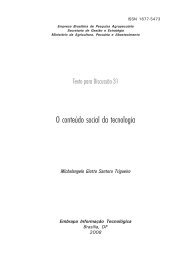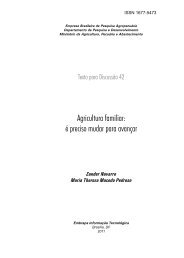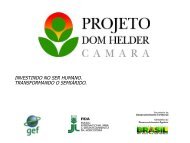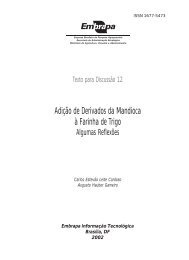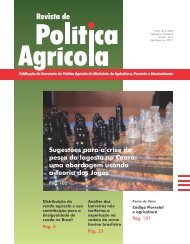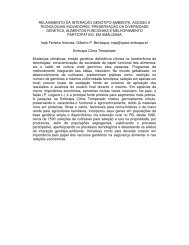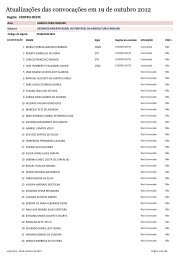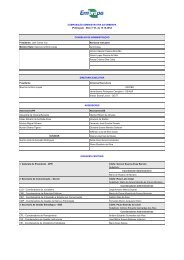Ministry of Agriculture, Livestock and Food Supply - Embrapa
Ministry of Agriculture, Livestock and Food Supply - Embrapa
Ministry of Agriculture, Livestock and Food Supply - Embrapa
Create successful ePaper yourself
Turn your PDF publications into a flip-book with our unique Google optimized e-Paper software.
production is concentrated in the State <strong>of</strong> Rio Gr<strong>and</strong>e do Sul. Santa Catarina, the<br />
second largest rice producer in the country, is the largest parboiled rice producer.<br />
According to the IBGE (2003), Rio Gr<strong>and</strong>e do Sul <strong>and</strong> Santa Catarina produce<br />
700,000 tons/year <strong>of</strong> unhulled rice.<br />
The moisture content <strong>of</strong> the paddy leaving the field varies from 25% to 30%<br />
depending on the farming conditions <strong>and</strong> time <strong>of</strong> year. The moisture content must<br />
be reduced to 12-15% before milling <strong>and</strong> to no more than 13% for storage. The<br />
combustion gases from burning the hulls are used as heat source for drying the<br />
grains. Mills that produce only white rice do not require steam. The higher caloric<br />
power <strong>of</strong> dry-base rice hulls is 15.84 GJ/t. The lower caloric power <strong>of</strong> rice with<br />
11% moisture is 12.96 GJ/t, much higher than sugarcane bagasse.<br />
The following parboiled rice milling operations require steam: (i) soaking;<br />
(ii) autoclaving; (iii) parboiling, <strong>and</strong> (iv) drying, in some industries.<br />
Rice mills receive the harvested rice, which is taken to the mill as paddy.<br />
Approximately 15% <strong>of</strong> the hulls produced per year are burned to dry the rice;<br />
this operation usually takes place as the harvest proceeds (January through<br />
April) <strong>and</strong> consumes 60% <strong>of</strong> the hulls collected. It is estimated that only 50%<br />
<strong>of</strong> the total hull volume is used to produce electric power, since in addition to<br />
the 15% used in the drying operation, approximately 35% are produced in<br />
small, dispersed mills. The energy density <strong>of</strong> hulls is very low, so that<br />
transportation is only economically feasible with return freight.<br />
Carbon credit market <strong>and</strong> agroenergy<br />
Background<br />
Atmospheric CO 2 concentrations have increased by 31% in the last<br />
250 years (Figure 14), <strong>and</strong> have probably reached an all-time high. CO 2<br />
concentrations tend to increase significantly if greenhouse gas (GG) emissions<br />
are not kept under control. Fossil fuel burning <strong>and</strong> cement production account<br />
for almost 75% <strong>of</strong> GG emissions. Changes in l<strong>and</strong> use that dem<strong>and</strong><br />
deforestation have also contributed significantly: 25%.<br />
Global warming from anthropic sources – resulting from greenhouse<br />
gas emissions (GGE) – has been a source <strong>of</strong> concern to modern societies.<br />
These emissions occur associated with the growing dem<strong>and</strong>s for energy<br />
(from non-renewable sources mostly) resulting from population growth.<br />
Climate changes can have negative consequences for future generations.<br />
101



